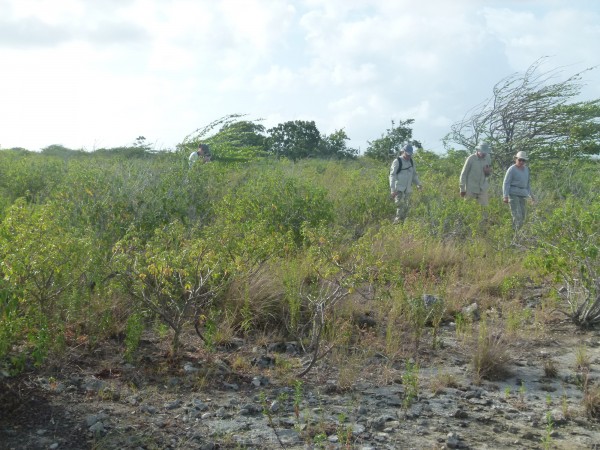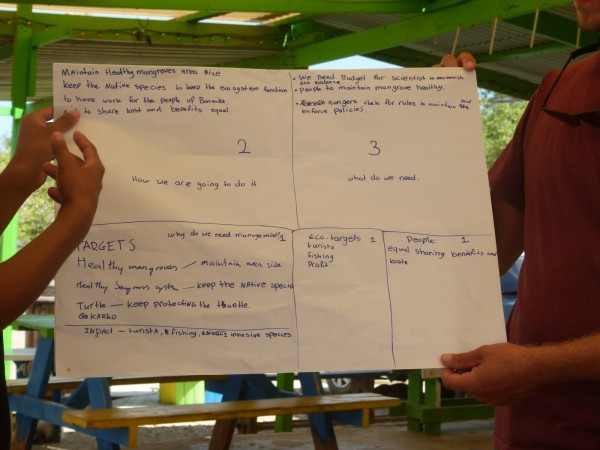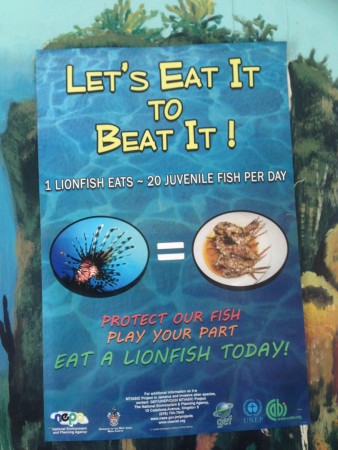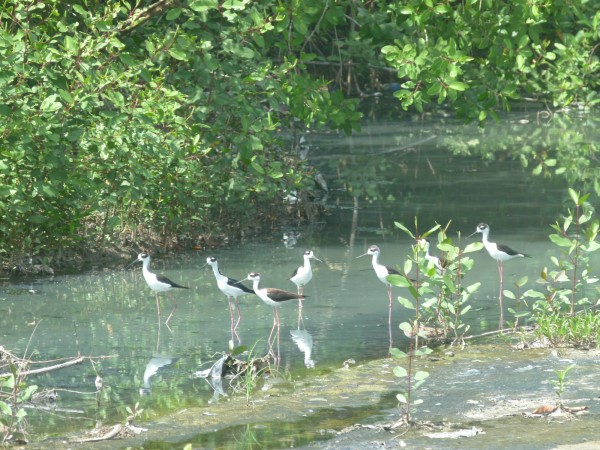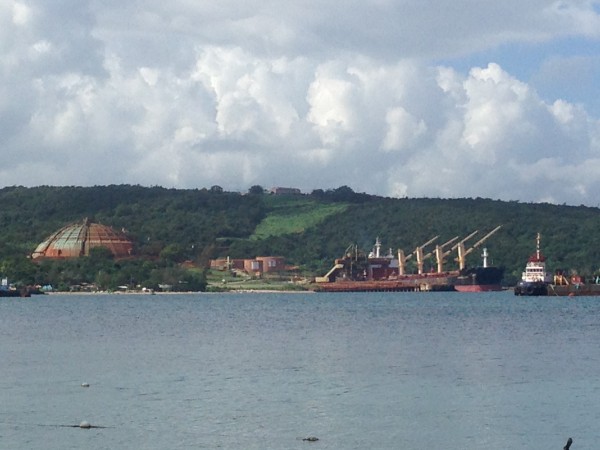Last week Lucy Gillis and I got back from Montego Bay, Jamaica after two and a half weeks of fieldwork that first started out in Bonaire, a Dutch Overseas Territory in the Lesser Antilles. We were supported by Ines Viana Gonzalez (formerly with the Algae and Seagrass Ecology WG), also a team member who was in based in Portugal at the time.
Our interdisciplinary fieldwork was undertaken as a part of a ZMT Core Budget funded interdisciplinary project CIRCULATIONS (Traveling Seagrasses in the Caribbean Sea), with Sabine Engel (STINAPA, Bonaire), together with Camilo Trench and Mona Webber (University of the West Indies Marine Lab), as our main cooperation partners. As an interdisciplinary team (combining multispecies anthropology with coastal ecology), we wished to study a contemporary example of how species invasions - in this case Halophila stipulacea - has been somewhat positively or at least ambivalently framed at times by scientists and policymakers. We also set out to explore how and why other species such as Sargassum sp. (known for a longer time in the Caribbean Sea), came to be increasingly regarded as a ‘nuisance’ species, and in whose interests.
11.01.18
Sabine Engel (STINAPA) picked us from the airport and brought us over to our lodging during that week´s stay – an airy, spacious bedsitter managed by the Dutch Nature Caribbean Alliance (DCNA), located just next to their office. We had a chat about our weekend site visits with Sabine. Renting a car was probably the best solution as Bonaire does not have a public transport service and we needed to make frequent trips outside the main city - Kralendijk, on the lee side of the island - to the coastlines of further up north and east.
12.01.18
What a day it was – driving through dyer almost arid landscapes in the hinterland of its 112 mile island, dotted with cacti. Many of the shorelines were hauntingly sparse, with much of the tourist activity (i.e. smaller hotels, wind and kite surfing schools etc.) concentrated along particular areas of its eastern shoreline. We went past the ‘salt pyramids’ of Cargill – with its immense, pink salt pans that at sundown added more colour to the vast canvas of the horizon, peppered with a number of Bonaire´s resident flamingos in the distance. As we circumvented the island, we stopped by several sites, starting with Lac Bay on the southeast, one of the most biodiverse rich marine parks in the Caribbean. As we drove along north, we stopped at more isolated sites to inspect a number of smaller seagrass beds, and patches of mangrove forest. One of these sites had mounds of Sargassum sp. that was washed ashore. The shorelines of Bonaire come across as a geologists´ dream – and you can find out why!
14.01.18
The last few days was spent organizing interviews with key stakeholders Sabine and Teneke (DCNA) helped us get in touch with over the last month before we travelled in. interviewed a range of stakeholders spanning state agencies, scientists, NGOs, community-based organizations and businesses which included representatives from the Ministry of Economic Affairs, Agriculture and Innovation, the Department for Nature and the Environment (OLB) , the DCNA, STINAPA, a recently formed fisher cooperative, Sea Turtle Conservation (STCB), a divers´ group, the Jive Center, the WildSurf Place, and the Mangrove Center. The stakeholders interviewed offered diverse and nuanced perspectives on marine invasive and nuisance species, offering both local as well as regionally embedded visions and management strategies. Sabine also planned a boat trip across a number of mangrove forest spaces and channels that STINAPA has been clearing to facilitate the circulation of water; Lucy spotted a Halophila stipulacea that had gone right into these mangrove sites.
15.01.18
Somewhat anxious. We´re making a public presentation of our work – and what we are doing in Bonaire- at the DCNA on Tuesday within the collaborative frame of the STINAPA-DCNA lecture series “Connecting People with Nature.” There aren’t preliminary findings to present at this point. So our interdisciplinary talk was placed against a broader narrative of socio-ecological perceptions of invasive species arrival and their management. “Be warned”, one of the organizers wryly smiled, “you two are talking about seagrasses after all…not sharks!” In all honesty, we didn´t anticipate much of a crowd; yet by the time the room filled we were heartened to see a diverse group of people – from ex-park rangers from STINAPA and their other staff, to a number of scientists visiting from the UK and the Netherlands, dive instructors, civil servants from a number of state agencies such as the Tourism Board, and interested members of the public. The talk was followed by a lively discussion, also with contributions from Dr. Dolfi Debrot (Wageningen Marine Research), who was also visiting at the time.
17.01.18
Yesterday´s schedule was rather packed as we drove across the island to make it in time for our different appointments – comprising semi-structured interview discussions starting first at Bonaire´s Ministry of Agriculture, the Department for Nature and the Environment (OLB), several windsurf schools, including the Sea Turtle Conservation (STCB), a divers´ group, the Mangrove Center and a newly formed fisheries cooperative. We set of at around 7am to Klein Bonaire – a trip organized by STINAPA with a boat to take us out. We walked through the smaller island sites as STINAPA pointed out native plants that they were reintroducing, also in the light of several ‘exotic’ species that were brought into mainland Bonaire because they were considered to look more aesthetically ‘tropical.’ More site visits and interviews the next day – we stopped at the famous Lion Fish burger truck for a lion fish wrap on our way back, with one of the island´s famed endemic green iguanas to keep us company.
19.01.18
We couldn´t have thought of a better way of wrapping up our fieldtrip to Bonaire. We´d planned on facilitating a tour with youth groups, and STINAPA´s Young Rangers stepped up. The first part of the ‘walk-shop’ in Lac Bay comprised a practical aspect looking at invasive seagrass species and their possible effects on connectivity between mangrove forests, seagrass beds and coral reefs. The second part entailed a role-play exercise in which junior rangers split into contending groups in order to design and convince an international donor organization why it was worth funding a particular marine management plan for Lac Bay.
21.01.18
Finally arrived at Montego Bay, following a chilly overnight layover in New Jersey. We were put up at the beautiful grounds of the Discovery Bay Marine Lab, affiliated to the University of the West Indies at Mona (Center for Marine Sciences) where Camilo Trench and Mona Webber are. The following day had planned interviews with the National Environment and Planning Agency, the Ministry of Fisheries, and a number of fisher cooperatives in Discovery Bay and Montego Bay. Some of them were in Kingston so over those several days we set off early to beat the traffic. We also visited several fish sanctuaries for one site group interviews with the reserve managers and fisherfolk. More exciting posters festooning the walls of fisher cooperative buildings – on urging people to catch and eat invasive lion fish.
24.01.18
Visited the Mona campus to meet with Professor Mona Webber – for an interview and a discussion on the challenges of spotting invasive seagrasses, also against the context of national priorities that placed emphasis on overfishing, coastal erosion and degradation etc. We had an interesting discussion on the politics and practices of creating artificial reef systems, including the challenges of enforcing regulations for resorts and hoteliers when transforming beach frontages and clearing seagrass beds.
We spent a day organizing and hosting a stakeholder Roundtable that was planned with scientists, key consultants and local NGO groups like Alligator Head.
We wrapped up our stay with several other interviews this time with scientists – including Camilo – at base.
Concluding thoughts… (on our way home, via Atlanta and Paris…)
Something that struck both of us was the fact that although in some contexts the focus on managing invasives was seemed more visible, the ambiguity with regard to how best to manage seagrasses – and how those that at times offered (positive) ecosystem services and ecological functions (such as turtle food), was perceived. In some sites, like in Jamaica, there were considerable questions on whether Halophila stipulacea had in fact arrived in the first place, and what was seen was in fact the same seagrass species? Our fieldwork also raised pertinent questions regarding the biopolitics of invasive species (particularly when they come with mixed/ambivalent reactions), and particularly when they concern ecosystems that are relatively non-charismatic – unlike tropical reefs and more recently mangrove spaces. Public awareness and the appreciation of seagrass beds as an ecosystem in itself has been gradually growing (particularly among fishing and diving communities), however it still captures very little of the mainstream media and donor imagination. “To folk on land, they are like weeds… and what do you do with unwanted weeds in a garden?”, remarked an elderly female diver in Bonaire.







